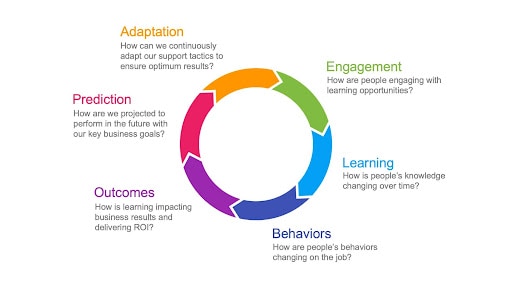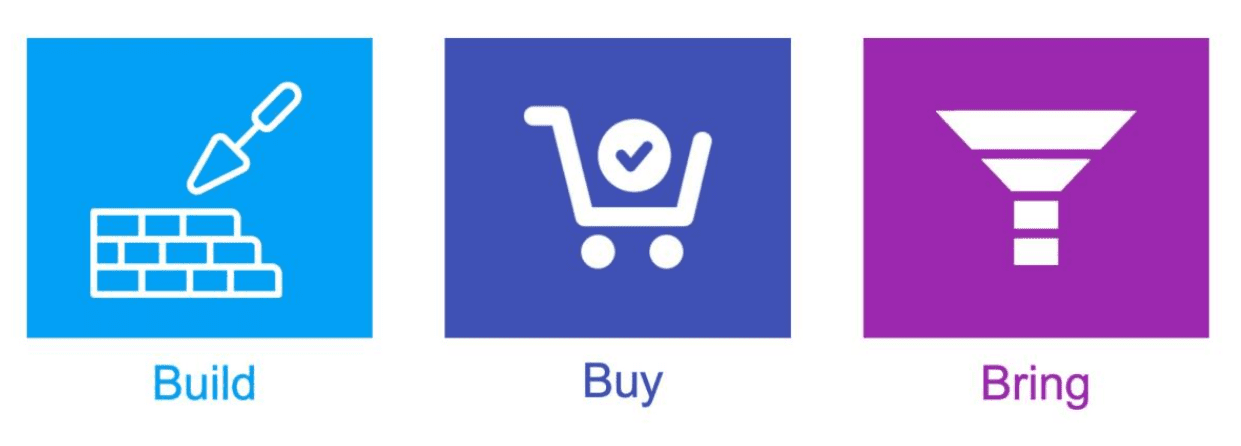
Two companies (A and B) spent $5000 on a new digital training course for their sales teams. The companies are nearly identical. Both have 100 salespeople and operate in the same region. Both companies released the new course on the same day with similar marketing messages.
- All 100 salespeople at Company A completed the course and rated it favorably.
- Only 1 salesperson at Company B completed the course, and they also rated it favorably.
Which company got a better return for their training content investment?
Here’s more detail for you to consider.
- Company A did not experience a meaningful increase in sales after their team completed the course.
- Company B did see an increase in sales – just for the salesperson who completed the course. Their sales went up 10% – almost $10,000.
Which company got a better return for their content investment?
Yes, this is an implausible scenario. If either situation happens in your company, something strange is going on. With the information provided, you cannot accurately determine if Company A or B made a good investment. The same is probably true for your company and the resources you’re spending on training content right now. Completions and satisfaction scores are not indicators of value.
So what can you do to stop wasting time and money on training content that doesn’t work?
Solution for Results
To get the most value from your content, you have to make sure you have the right content in the first place. Every learning management system (LMS) is chock-full of expensive courses that no one ever uses. More content does not result in more learning. In our introduction story, the example course was the right solution for one person in Company B but the wrong option for 99 others who did the same job.
Moving forward, Company B must apply a rigorous, systematic solutioning process that focuses on results, not content.

This “inverted design” approach begins with the end result: a clear, measurable business outcome. Ask your business stakeholders to clarify how they know they have a performance challenge that requires training in the first place. How are they measuring this problem? And how would they like to see this key performance indicator change as a result of your solution?
For Company B, the desired outcome was to increase sales of a new product by 15%.
Next, you must determine how on-the-job behavior influences the desired result. Collaborate with subject matter experts to determine what people must do in order to make the outcome achievable. How does their everyday behavior need to change? What does optimal performance look like in real life?
Company B noticed salespeople who consistently close deals for their new product are able to overcome a common buyer objection regarding the delivery process.
Then, you can determine what knowledge/skill is required to enable each required job behavior. What do people have to know in order to perform at the expected level every day? Do they need to retain this knowledge, or can they reference information on the job?
Company B determined the key to overcoming the primary buyer objection was to have a strong understanding of all delivery options.
Finally, you can make a decision regarding the right-fit solution. However, you will only build what you absolutely need in order to reach the desired result. This process will help you expand your toolkit beyond traditional courses. If a job aid will help people acquire the necessary knowledge and execute the right behaviors, then build a job aid. If they just need more practice, provide scenario-based questions and coaching. And, if they require considerable knowledge and skill development, a full-fledged training program may be the right thing to do after all.
Company B was able to avoid building an entire retraining program on the new product. Instead, they reinforced the sales team’s knowledge of customer delivery options with an article and a series of scenario-based questions.
Measure for Impact
A results-focused approach will help you make informed content decisions. It will also help you improve your measurement practices. Each step along the process provides a potential data point to connect your solution to your targeted outcome.

Learning measurement should not be approached as a linear process. People are constantly changing. They learn, and they forget. They receive helpful coaching and develop bad habits that negatively influence their job performance. Therefore, measurement must be a continuous process. By assessing ongoing changes in employee engagement, knowledge, behavior and results, you can determine how your solutions are (or are not) impacting your business. You can then make proactive decisions to change, add or remove solutions rather than allowing them to become stale and valueless.
Company B already had several measurement tactics in place. Sales results were assessed using a variety of metrics, including revenue and conversion rates. On-the-job behavior was measured through call evaluations. They introduced scenario-based practice activities to measure iterative changes in team knowledge over time. When this data was analyzed together, they could clearly see the impact of training on sales knowledge, behavior and results.
Build, Buy or Bring?
Results-focused design will point you to the right solution. Measurement will connect that solution to business value. But where should you get that solution? Should you build it in-house? Should you buy it from a vendor? Or should you bring it together (curate doesn’t begin with a ‘b’) using existing resources and user-generated content? Yes, and …

Corporate training is a lot like streaming television. There’s a seemingly endless supply of content. Sadly, most of that content isn’t very useful. Netflix developed a robust recommendation algorithm to personalize your experience, but you still spend hours clicking around to find something you actually want to watch. Your employees don’t have the time or patience to browse through an unwieldy content catalog.
Content agility is essential in a modern learning organization. You must be able to get the right solution to the right people at the right time so your employees are prepared to overcome their next challenge. And you have to do this at the speed and scale of your business. As Company B learned, throwing a pile of generic online courses into an LMS doesn’t create agility. Neither does plugging a long list of external content providers into a learning experience platform (LXP). Instead, you must balance your content sourcing to maximize your efficiency, manage your costs and achieve your desired business outcome.
- Buy for foundational and heavily-regulated topics. At the end of the day, how many ways can someone climb a ladder? You should not waste time and resources developing training on common subjects, such as ladder safety. Identify topics that have either conventional knowledge/skill requirements or external regulatory requirements. Acquire these solutions from proven content providers.
- Build for proprietary and unique topics. Your products and processes are specific to your organization. Your team may require training on topics that aren’t available from external providers. In these cases, provide the resources needed to build and maintain right-fit solutions.
- Bring for nuanced and timely topics. You don’t have enough resources to buy or build content on every possible topic. Plus, some challenges appear too quickly or impact such a small group that formal training doesn’t make sense. Lean into curated and user-generated solutions for specialized and timely topics.
Company B decided to build their new solutions because their delivery processes are unique to their organization.
Applying a results-focused, agile content approach results in a much better ending to the Company B training story this time around. L&D spent their limited time and resources on just what was needed to solve the real problem. Salespeople spent their limited time and attention on relevant, high-value training. L&D was able to determine how their solution directly impacted employee performance and business results.
Isn’t that the training story we all want to tell?
